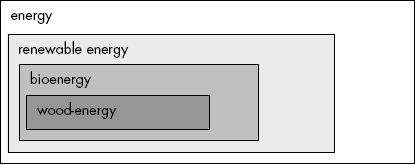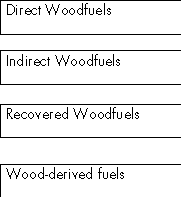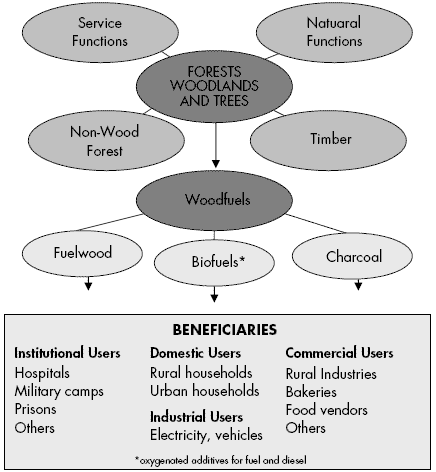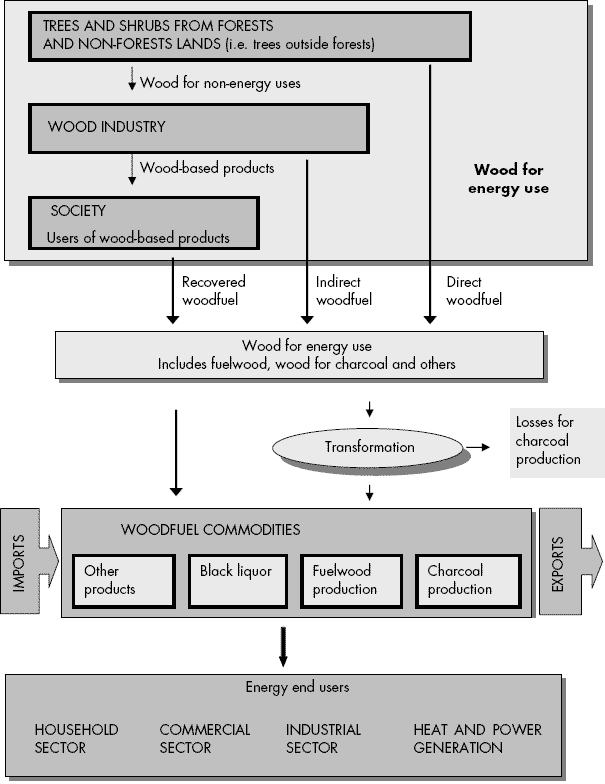


Biofuels are already related to both energy statistics and forest statistics. In line with the classification described in Figures 1 to 3, in energy statistics the term bioenergy covers all energy derived from biofuels. It comprises purpose-grown energy crops, managed natural forests, multipurpose plantations and by-products (residues and wastes) from both production and processing areas. Biomass may be considered as one form of transformed solar-energy. From this point of view bioenergy is a renewable energy source (see Figure 4). 3

Figure 4: Bioenergy in the energy statistics field
Based on the conceptual approach discussed earlier, a detailed scheme for classifying biofuels is presented in Table 5. The prime consideration behind the suggested classification is to identify the basic site where biomass production takes place; thus it seeks to distinguish whether the biofuel was connected to forest, agricultural or municipal activities. The inclusion of a group on the use of agrofuels aims at distinguishing classical biofuels (generally related to forest exploitation) from those oriented towards annual or pluri-annual plantation.
The groups on the supply side clearly identify the origin of biofuels. On the end user side, the variety of fuels that can be produced for each group can be observed, thus allowing for data comparison and verification on both supply and demand. The right-hand column of Table 5 lists the different types of primary, secondary and tertiary fuels which can be used for heat, electricity and power generation. Secondary and tertiary fuels are often derived from raw biomass produced following of relatively complex transformation processes.
The main definitions employed in UBET include three types of biofuel: woodfuels, agrofuels, and municipal by-products (the term “by-products“ includes the improperly called solid, liquid and gaseous residues and wastes derived from biomass processing activities).
Table 5: Biofuel classification scheme
Production side, supply |
Common groups |
Users side, demand examples |
 |
 |
|
|
 |
|
 |

|
|
Woodfuels are included in the sector of forests, woodlands and trees (Figure 5). Woodfuels include all types of biofuels derived directly and indirectly from trees and shrubs grown on forest and non-forest lands. The definition of forest according to FAO Forest Resource Assessment 20054 is rather broad and includes land with a minimum tree crown cover of 10%. Woodfuels also include biomass derived from silvicultural activities (thinning, pruning etc.) and harvesting and logging (tops, roots, branches, etc.), as well as industrial by-products derived from primary and secondary forest industries which are used as fuel. They also include woodfuels derived from forest energy plantations.

Figure 5: Woodfuels in the forests, woodlands and trees field [FAO, 1995]
Figure 6 presents a conceptual view of wood energy systems. The figure introduces the three different supply sources: nature (forests and trees-outside forests), wood industries and society and the main products involved. The user’s side is also represented, shared among the main demand sectors. Additional considerations regarding wood energy trade complete the picture. As regards the commodities to be considered in wood energy accounting, woodfuels can be divided into four types of products: fuelwood, charcoal, black liquor and other. Table 6 summarises the main supply sources for the different types of woodfuels.

Figure 6. Woodfuel balance scheme, from supply sources to end users
Table 6. Woodfuel types from different supply sources
| Supply side (sources) | |||
| Commodities |
Direct Woodfuels |
Indirect Woodfuels |
Recovered Woodfuels |
| Fuelwood |
X |
X |
X |
| Charcoal |
X |
X |
X |
| Black liquor |
X |
||
| Other (methanol, ethanol, pyrolitic gas) |
X |
X |
X |
These are fuels obtained as a product of agriculture biomass and by-products at farming level, and/or industrial processing of raw material (agroindustries). The term covers mainly biomass materials derived directly from fuel crops (see Tables 5 and 7) and agricultural, agroindustrial and animal by-products. In the future more attention will be given to the definition of different types of agrofuels which so far have received marginal attention. This will cover both the terminology used but also for the development of improved data bases.
Table 7: Classification of fuel crops
| classification |
description/example | |
| land farms |
sugar/starch crops |
crops planted basically for the production of ethanol (ethyl alcohol) as a fuel mainly used in transport (on its own or blended with gasoline). Ethanol can be produced by the fermentation of glucose derived from sugar-bearing plants (like sugar-cane) or starchy materials after hydrolysis |
| oil crops |
oleaginous plants (e.g. sunflower, rape, etc.) planted for direct energy use of vegetable oil extracted, or as raw material for further conversion into a diesel substitute, using transesterification processes | |
| other energy crops |
include plants and specialized crops more recently considered for energy use, such as: elephant grass (Miscanthus), cordgrass and galinggale (Spartina spp. and Cyperus longus), giant reed (Arundo donax) and reed canary grass (Phalaris arundinacea) | |
| marine farms |
algae | |
| fresh water farms |
water hyacinths | |
This refers to biomass by-products produced by the urban population and comprise two types: solid municipal by-products, and gas/liquid municipal by-products produced in cities and villages.
Solid municipal biofuels: comprises by-products produced by the residential, commercial, industrial, public and tertiary sectors that are collected by local authorities for disposal in a central location, where they are generally incinerated (combusted directly) to produce heat and/or power. Hospital waste is also included in this category.
Gas/liquid municipal biofuels: biofuels derived principally from the anaerobic fermentation (biogas) of solid and liquid municipal wastes which may be land-fill gas or sewage sludge gas.
For easy reference, Table 8 provides brief definitions of the main terms adopted. Table 9 provides some examples for the biofuel classification proposed.
Table 8: Proposed Definition of Biofuel Classifications
1st level |
2nd level |
Brief definition |
Woodfuels |
Direct Woodfuels |
Wood from forests, shrubs and other trees used as fuel |
Indirect Woodfuels |
Mainly solid biofuels produced from wood processing activities | |
Recovered Woodfuels |
Wood used directly or indirectly as fuel, derived from socio-economic activities outside the forest sector | |
Wood-based fuels |
Mainly liquid and gaseous biofuels produced from woody biomass | |
Agrofuels |
Fuel crops |
Growing plants for the production of biofuels |
Agricultural by-products |
Mainly by-products from crop harvesting and other kinds of by-products from agricultural activities left in the field | |
Animal by-products |
Primarily excreta from cattle, horses, pigs and poultry | |
Agro-industrial by-products |
Several kinds of biomass materials produced chiefly in food and fibre processing industries, such as bagasse and rice husks | |
Municipal by-products |
Several kinds solid and liquid municipal biomass materials produced in urban societies | |
Table 9: Examples for proposed biofuel classification
Example |
classification for statistics |
whole tree chips |
direct, primary, solid, woodfuel |
black liquor |
indirect, primary, liquid, wood-based fuel |
charcoal briquette |
direct (or indirect or recovered) secondary, solid, wood-based fuel |
demolition wood |
recovered, primary, solid, woodfuel |
plant methyl ester (PME) |
secondary, liquid agrofuel from fuel crops |
ethanol from bagasse |
secondary, liquid agrofuel from agricultural by-product |
biogas from MSW digestion |
secondary gaseous municipal by-product fuel |
3 An overview on bioenergy production and consumption is given in the bioenergy balance.
4 FAO Forestry web site. Forestry Terminology: URL www.fao.org/forestry/site/25210/en